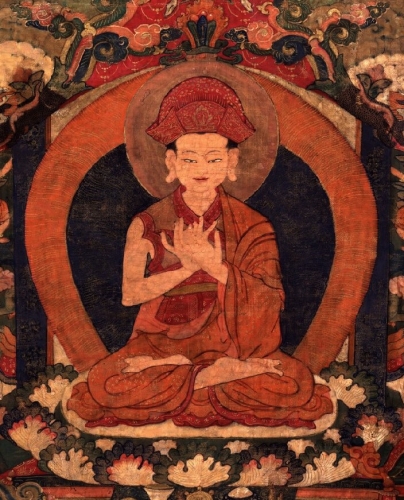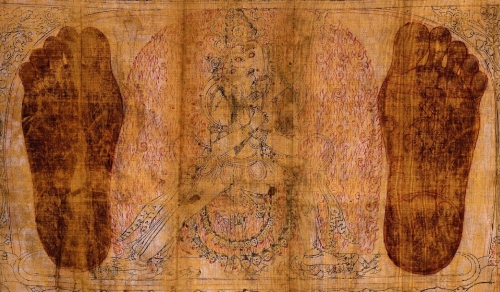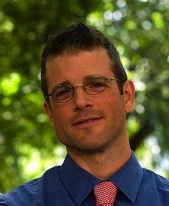Biography and autobiography in Tibet are important sources for both education and inspiration. Tibetans have kept such meticulous records of their teachers that thousands of names are known and discussed in a wide range of biographical material. All these names, all these lives—it can be a little overwhelming. The authors involved in the Treasury of Lives are currently mining the primary sources to provide English-language biographies of every known religious teacher from Tibet and the Himalaya, all of which are organized for easy searching and browsing. Every Tuesday on the Tricycle blog, we will highlight and reflect on important, interesting, eccentric, surprising and beautiful stories found within this rich literary tradition.
Part 1: Mila and Marpa
Part 2: Gampopa and Barompa
Part 3: First Karmapa and Lama Zhang
Part 4: Pakmodrupa and Gyergom Tsultrim Sengge
Part 5: Taklungtangpa and Sanggye On
Kagyu Founders, Part 6: Marpa Sherab Yeshe and Jikten Gonpo

Of the eight disciples of Pakmodrupa (1110–1170) credited with establishing the eight “minor” traditions—”minor” because they were one generation removed from Gampopa (1079–1153), whose disciples established the four “major” traditions—only a few created institutions that continued to thrive long after their deaths. Those Kagyu traditions that have come down to us today have done so thanks in large part to the enduring success of their founding monasteries. Such is the case of the Drigung Kagyu, based at the monastery of Drigung, founded by Jikten Gonpo (1143–1217). The Martsang Kagyu suffered a different fate. Established by Marpa Sherab Yeshe (1135–1203), it ceased to exist as an independent tradition soon after Mongol invaders destroyed its two monasteries in the 18th century.
Marpa Sherab Yeshe was born in Markham, Kham. He took refuge with a famous translator named Ga Lotsawa and, after studying with the lamas of the region and taking ordination, left for Central Tibet as a young man. He stayed first at the philosophically oriented monastery of Sangpu Neutok while he sought out tantric teachings of the Ngok tradition, a family lineage of Hevajra and other tantras. Some time around 1160 he met Pakmodrupa, who finished his training.
In 1165 Sherab Yeshe returned to his homeland and, two years later, established Sho Monastery. It flourished in his lifetime, housing upwards of a thousand monks. The Martsang Kagyu was known for its adherence to the Kadampa commentaries on the sutras alongside the tantric traditions that were passed down from Marpa to Milarepa, such as the Six Yogas of Naropa, the Hevajra and Cakrasamvara tantras. Sho and other Martsang Kagyu monasteries were initially destroyed at the end of the 17th century and then again at the start of the 18th century, after which they were not rebuilt. The tradition essentially ceased to exist.

The Drigung Kagyu tradition of Jikten Gonpo Rinchen Pel, on the other hand, continues to thrive, despite Drigung Monastery having been destroyed and rebuilt several times over the course of the last 900 years. Rinchen Pel, like Sherab Yeshe, was born in Kham, his father a tantric teacher of Vajrabhairava. But his parents died young, and he was forced to support himself and his siblings by reciting scriptures in people’s homes. Although he developed a reputation as a healer and magician, when he heard the name Pakmodrupa he immediately resolved to become his student.
Jikten Gonpo was 25 when he met Pakmodrupa, who gave him complete teachings, likely treasuring him above most other students. Later, during a two-year retreat, Jikten Gonpo was stricken with leprosy. He first felt dejected, but then, reflecting on how fortunate he was to have received instruction from Pakmodrupa, felt sorrow that all beings could not receive such a blessing. He then felt the disease flowing out of his body, “swept away in the wind,” and experienced a vision of a giant snake spirit departing, after which he enjoyed a full recovery. He used the experience to fashion a practice for others stricken with the disease.
In 1177, seven years after Pakmodrupa died, Jikten Gonpo fulfilled his teacher’s wishes and took complete ordination. Fully embracing the Vinaya rules at the age of 34, he briefly served as abbot of Pakmodrupa’s monastery, Densatil. Then, in 1179, he established the monastic community of Drigung, which attracted many students and patrons, quickly becoming a formidable institution—it is said that by the year 1200 there were 13,000 monks attending teachings there. Jikten Gonpo’s name was known across Inner Asia, among the Tangut Kingdom, and in China. His famous teachings, The Five Profound Paths of Mahamudra and The Single Intention, became central to the Drigung Kagyu tradition. Thanks to a long line of powerful and confident abbots, Drigung Monastery remained a powerful presence in Tibet that was rebuilt each time it was destroyed in regional or international conflicts. The monastery thus ensured the survival of the tradition.
Continue to Part 7: Rinchen Gon and Jampa Pel
 Meet your Treasury of Lives blogger: Alexander Gardner has a PhD from the University of Michigan in Buddhist Studies and serves as the Associate Director of the Rubin Foundation.
Meet your Treasury of Lives blogger: Alexander Gardner has a PhD from the University of Michigan in Buddhist Studies and serves as the Associate Director of the Rubin Foundation.
Thank you for subscribing to Tricycle! As a nonprofit, we depend on readers like you to keep Buddhist teachings and practices widely available.